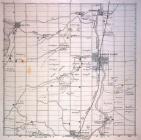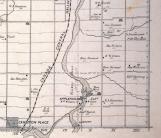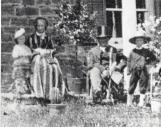1
The history of Appleton begins in the early 1820s in Ireland and Scotland where thousands of underemployed and landless families decided to make a new life for themselves in the New World. Many of these families had no money to pay for the expensive voyage across the Atlantic and no supplies to begin their lives in the new country.At the same time, the British government had two major concerns to be dealt with. Firstly, the government was looking to increase the population of Upper Canada in order to protect the land from the Americans to the South. This defensive strategy was in response to American aggressions during the War of 1812. Secondly, the government was looking to find jobs for the underemployed and unemployed of England, Scotland and Ireland. With the conclusion of the Napoleonic Wars the British textile industries were suffering from a decline in orders. Thousands of textile workers were unemployed and the British government feared social upheavals like the ones that had taken place in France.
2
The desires of the underemployed to improve their lives and the concerns of the British government came to together as a movement to help citizens emigrate to Upper and Lower Canada. The British government encouraged the formation of emigration societs which helped fund the ocean passage to Quebec for large groups of settlers. Upon landing the British government then provided land grants and supplies. There were also emigrants who paid their own passage to Ramsay Township.3
Map of Ramsay Township, Lanark County1880
Ramsay Township, Ontario, Canada
 Credits:
Credits:McGill University, Rare Books Collection
4
In Ramsay Township much of the early population came to the area with the help of the Lanark Society Settlers. This migration was predominately Scottish, with a large group arriving in Ramsay in 1820 and 1821. The group landed in Quebec City and travelled by steamboat to Montreal then by flat bottom boat to Prescott. At Prescott the group then travelled by foot to Perth where they received their land grants. From Perth the group then continued on foot through the bush to claim their lots across Lanark County. Each family or man over twenty-one was given one hundred acres of land and supplies.5
In addition to the free land, the Lanark Society Settlers received some rations and supplies from the government. The rations included: one pound of bread and one pound of pork per man, half a ration per woman, one-third a ration per child over seven and one-quarter a ration per child under seven.In order to help the settlers survive and prepare for the winter, the government also supplied: bedding, blankets, panes of glass, putty, pine boards, nails, seeds, and tools including: felling axes, a broad axe, hand saws, locks & keys, door hinges, iron wedges, pitch forks, iron pots, frying pans, gimlets, files, chisels, augurs, scythes, sickles, spades, shovels, pick axes, broad hoes, narrow hoes, carpenter's hammers, adzes, drawing knives, brush hooks, harrow teeth and planes.
6
In 1823 there was another large influx of settlers to Ramsay Township. This time they were the Peter Robinson Irish Settlers. Again these settlers travelled by ship to Quebec City, by steamboats to Lachine and then on flat-bottomed boats to Prescott. In Prescott the land grants were confirmed and the entire group travelled together, by foot, to Ramsay Township . In Ramsay, Peter Robinson set up a store house in Shipman Mills (Almonte) where the rations, medicines, tools and cattle were handed out.Some settlers also came to Lanark County via the Ottawa River.
7
Appleton, Ramsay Township1880
Appleton, Town of Mississippi Mills, Ontario, Canada
 Credits:
Credits:McGill University, Rare Books Collection
8
The Teskey family came to Ramsay Township as part of the Peter Robinson Settlers in 1823 and with their land grants built a grist mill and sawmill in an area called Apple Tree Falls. Apple Tree Falls soon became known as Teskeyville and eventually became our community of Appleton.9
Teskey Family Playing Croquet (L-R: Ethel, Jane, Robert, Albert)Circa 1880s
Appleton, Town of Mississippi Mills, Ontario, Canada
 Credits:
Credits:North Lanark Regional Museum (2012.55.37c)
Donated by Sheila Babb and Ann E. Love
10
These dioramas were made by Norman Paul of Mount Blow Farm, Ramsay Township in the 1980s. The late Norman Paul was known across Ramsay Township for his whittlings depicting local pioneer life. Norman used to travel to schools, fairs and other events to display his dioramas and give presentations on pioneer life. When the North Lanark Regional Museum opened in Appleton in 1970, Norman donated the majority of his pieces to the museum where they continued to be on display for the public. Unfortunately the museum burned down in 1979 and the collection was destroyed. Fortunately Norman Paul decided to remake the dioramas and again donated them to the rebuilt museum in the 1980s.11
Sugar Making1823-1980
Ramsay Township, Ontario, Canada
 Credits:
Credits:North Lanark Regional Museum (2007.42.28)
Donated by Norman Paul
12
These two dioramas show what life was life for the pioneers of Ramsay Township. Early settlers were always busy chopping wood, harvesting crops, raising livestock, spinning wool, cooking and raising children. Sugar making was also an important process at winter's end. Gathering sap and boiling it provided maple syrup and maple sugar for the year. The syrup and sugar could be used by the family or traded for other goods13
Mount Blow Farm 1821-19801821-1980
Ramsay Township, Ontario, Canada
 Credits:
Credits:North Lanark Regional Museum (2007.42.26)
Donated by Norman Paul
14
This storyline was produced by the North Lanark Historical Society and the North Lanark Regional Museum in Appleton, Ontario (Town of Mississippi Mills). The majority of the research for this project was conducted at the North Lanark Regional Museum using the collection, archives, library and 2012 oral history interviews. The oral history interviews were part of the 2012 "Digitally Preserving the Past for the Future" project, funded by the Museums and Technology Fund through the support of the Government of Ontario, Ministry of Tourism, Culture and Sport. These oral interviews are a great source of local history. Summaries of the interviews are available on our website and the full interviews can be viewed on-site at the museum.To learn more about the settlement of Ramsay Township please contact the staff or volunteers at the museum:
WEBSITE: www.northlanarkregionalmuseum.com
PHONE: 613-257-8503
EMAIL: appletonmuseum@hotmail